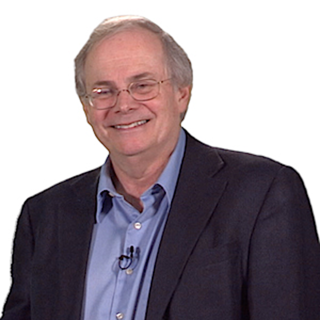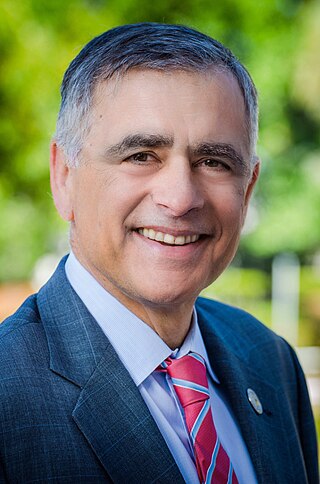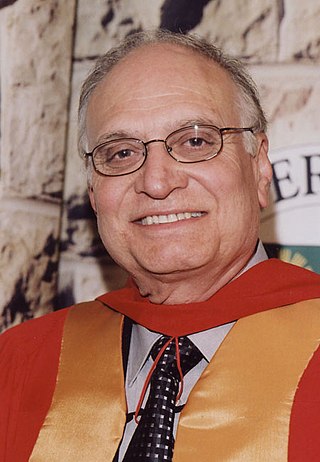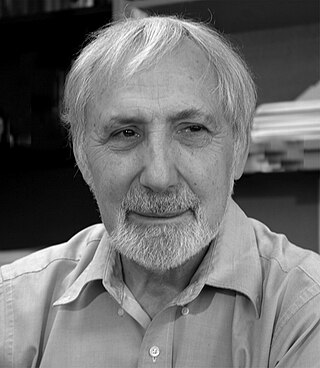Related Research Articles
In biochemistry, dephosphorylation is the removal of a phosphate (PO43−) group from an organic compound by hydrolysis. It is a reversible post-translational modification. Dephosphorylation and its counterpart, phosphorylation, activate and deactivate enzymes by detaching or attaching phosphoric esters and anhydrides. A notable occurrence of dephosphorylation is the conversion of ATP to ADP and inorganic phosphate.

Vernon Martin Ingram, was a German–American professor of biology at the Massachusetts Institute of Technology.

Frederic Middlebrook Richards, commonly referred to as Fred Richards, was an American biochemist and biophysicist known for solving the pioneering crystal structure of the ribonuclease S enzyme in 1967 and for defining the concept of solvent-accessible surface. He contributed many key experimental and theoretical results and developed new methods, garnering over 20,000 journal citations in several quite distinct research areas. In addition to the protein crystallography and biochemistry of ribonuclease S, these included solvent accessibility and internal packing of proteins, the first side-chain rotamer library, high-pressure crystallography, new types of chemical tags such as biotin/avidin, the nuclear magnetic resonance (NMR) chemical shift index, and structural and biophysical characterization of the effects of mutations.

David S. Eisenberg is an American biochemist and biophysicist best known for his contributions to structural biology and computational molecular biology, a professor at the University of California, Los Angeles since the early 1970s and director of the UCLA-DOE Institute for Genomics & Proteomics since the early 1990s, as well as a member of the California NanoSystems Institute (CNSI) at UCLA.

Daniel Edward Koshland Jr. was an American biochemist. He reorganized the study of biology at the University of California, Berkeley, and was the editor of the leading U.S. science journal, Science, from 1985 to 1995. He was a member of the United States National Academy of Sciences, the American Academy of Arts and Sciences, and the American Philosophical Society.

Gregory A. Petsko is an American biochemist and member of the National Academy of Sciences, the National Academy of Medicine, the American Academy of Arts and Sciences, and the American Philosophical Society. He is currently Professor of Neurology at the Ann Romney Center for Neurologic Diseases at Harvard Medical School and Brigham and Women's Hospital. He formerly had an endowed professorship in Neurology and Neuroscience at Weill Cornell Medical College and is still an adjunct professor of Biomedical Engineering at Cornell University, and is also the Gyula and Katica Tauber Professor, Emeritus, in biochemistry and chemistry at Brandeis University.

Irwin Fridovich was an American biochemist who, together with his graduate student Joe M. McCord, discovered the enzymatic activity of copper-zinc superoxide dismutase (SOD),—to protect organisms from the toxic effects of superoxide free radicals formed as a byproduct of normal oxygen metabolism. Subsequently, Fridovich's research group also discovered the manganese-containing and the iron-containing SODs from Escherichia coli and the mitochondrial MnSOD (SOD2), now known to be an essential protein in mammals. He spent the rest of his career studying the biochemical mechanisms of SOD and of biological superoxide toxicity, using bacteria as model systems. Fridovich was also Professor Emeritus of Biochemistry at Duke University.

Serine/threonine-protein phosphatase 2A catalytic subunit alpha isoform is an enzyme that is encoded by the PPP2CA gene.
Oliver Howe Lowry was an American biochemist. He devised the Lowry protein assay, the subject of the most-cited scientific paper in history.
Hara Prasad Misra is an American biochemist and professor emeritus of biomedical sciences and pathology in the Virginia-Maryland Regional College of Veterinary Medicine at Virginia Tech. Misra is currently serving as vice president for research and graduate studies at the Virginia College of Osteopathic Medicine in Blacksburg, Virginia. Misra is a well-known teacher of undergraduate, graduate and DVM professional students for a period spanning over 30 years.
James A. Spudich is an American scientist and professor. He is the Douglass M. and Nola Leishman Professor of Biochemistry and of Cardiovascular Disease at Stanford University and works on the molecular basis of muscle contraction. He was awarded the Albert Lasker Basic Medical Research Award in 2012 with Michael Sheetz and Ronald Vale. He is a Fellow of the American Academy of Arts and Sciences and a Member of the National Academy of Sciences.
Mary Jane Osborn was an American biochemist and microbiologist known for her research on the biosynthesis of lipopolysaccharide, a key component of the outer membrane of Gram-negative bacteria, and discovering the mechanism of action of the anti-cancer drug methotrexate. She headed the Department of Molecular Biology and Biophysics at the University of Connecticut Health Center and served as president of the American Society for Biochemistry and Molecular Biology.

Sheldon M. Schuster is an American biochemist, cancer researcher and academic. He is the current president of Keck Graduate Institute as of 2003. He has previously served as a professor at University of Nebraska–Lincoln and University of Florida. While at Florida, he was the director of research and the university's biotechnology program.

Rajendra Kumar Sharma is a professor at the Department of Pathology and Laboratory Medicine, University of Saskatchewan College of Medicine. He holds an earned Doctor of Science from the University of Saskatchewan, and was elected a Fellow of the Royal Society of the Arts (FRSA) in 2014. His contributions to research have been documented in the Encyclopedia of Saskatchewan – A Living Legacy. Sharma has made several discoveries in the areas of colorectal cancer and the cardiovascular system.
Dr. Herbert Weissbach NAS NAI AAM is an American biochemist/molecular biologist.
Charles Clifton Richardson is an American biochemist and professor at Harvard University. Richardson received his undergraduate education at Duke University, where he majored in medicine. He received his M.D. at Duke Medical School in 1960. Richardson works as a professor at Harvard Medical School, and he served as editor/associate editor of the Annual Review of Biochemistry from 1972 to 2003. Richardson received the American Chemical Society Award in Biological Chemistry in 1968, as well as numerous other accolades.

Alexandra C. Newton is a Canadian and American biochemist. She is a Distinguished Professor of pharmacology at the University of California, San Diego. Newton runs a multidisciplinary Protein kinase C and Cell signaling biochemistry and cell biology research group in the School of Medicine, investigating molecular mechanisms of signal transduction in the Phospholipase C (PLC) and Phosphoinositide 3-kinase signaling pathways. She has been continuously funded by the US National Institutes of Health since 1988.

George Stark is an American chemist and biochemist. His research interests include protein and enzyme function and modification, interferons and cytokines, signal transduction, and gene expression.
Kuan Wang is a Taiwanese biochemist whose contributions to muscle biochemistry and cell biology have garnered more than 10,000 citations with an h-index of 54. After receiving a bachelor's degree in chemistry from Taiwan National University, he came to the United States for graduate study and earned a Ph.D. in molecular biophysics and biochemistry from Yale University under the guidance of Frederic M. Richards. He was an NIH Postdoctoral Fellow (1974–1976) at the University of California, San Diego, in the laboratory of S. J. Singer. In 1977 he joined the Department of Chemistry at the University of Texas at Austin as assistant professor. During his early years at UT, Wang and his co-workers discovered two previously unrecognized high molecular weight proteins of myofibrils, Titin and Nebulin, which fundamentally changed our understanding of muscle sarcomeres.

Bernard Leonard (Bernie) Horecker (1914–2010) was an American biochemist known for work on the pentose phosphate pathway, and for cellular regulation in general.
References
- ↑ "Departments". Archived from the original on 9 April 2008. Retrieved 24 March 2008.
- ↑ "2020 Blaisdell Distinguished Alumni Award Winners". Pomona College. 22 April 2020. Retrieved 11 March 2021.
- ↑ Brennan, T V; Anderson, J W; Jia, Z C; Waygood, E B; Clarke, S (1994). "Repair of spontaneously deamidated HPR phosphocarrier protein catalyzed by the L-isoaspartate-(D-aspartate) O-methyltransferase". J. Biol. Chem. 269 (40): 24586–24595. doi: 10.1016/S0021-9258(17)31432-1 . PMID 7929130.
- ↑ Hrycyna, Christine A.; Yang, Melody C.; Clarke, Steven (1994). "Protein Carboxyl Methylation in Saccharomyces cerevisiae: Evidence for STE14-Dependent and STE14-Independent Pathways". Biochemistry. 33 (32): 9806–9812. doi:10.1021/bi00198a053. PMID 8068661.
- ↑ Xie, H Y; Clarke, S (1994). "Protein phosphatase-2A is reversibly modified by methyl esterification at its C-terminal leucine residue in bovine brain". J. Biol. Chem. 269 (3): 1981–1984. doi: 10.1016/S0021-9258(17)42124-7 . PMID 8294450.
- ↑ Roher, A. E.; Lowenson, J. D.; Clarke, S.; Woods, A. S.; Cotter, R. J.; Gowing, E.; Ball, M. J. (1993). "Beta-Amyloid-(1-42) is a major component of cerebrovascular amyloid deposits: Implications for the pathology of Alzheimer disease". Proceedings of the National Academy of Sciences. 90 (22): 10836–10840. Bibcode:1993PNAS...9010836R. doi: 10.1073/pnas.90.22.10836 . PMC 47873 . PMID 8248178.
- ↑ University of California, Los Angeles (19 August 2019). "Biochemists discover new insights into what may go awry in brains of Alzheimer's patients". Science Daily . Retrieved 19 February 2021.